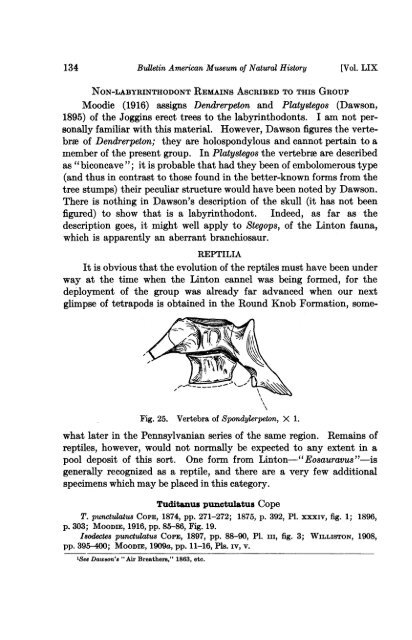View/Open - American Museum of Natural History
View/Open - American Museum of Natural History
View/Open - American Museum of Natural History
You also want an ePaper? Increase the reach of your titles
YUMPU automatically turns print PDFs into web optimized ePapers that Google loves.
134 Bulletin <strong>American</strong> <strong>Museum</strong> <strong>of</strong> <strong>Natural</strong> <strong>History</strong><br />
[Vol. LIX<br />
NON-LABYRINTHODONT REMAINS ASCRIBED TO THIS GROUP<br />
Moodie (1916) assigns Dendrerpeton and Platystegos (Dawson,<br />
1895) <strong>of</strong> the Joggins erect trees to the labyrinthodonts. I am not personally<br />
familiar with this material. However, Dawson figures the vertebrae<br />
<strong>of</strong> Dendrerpeton; they are holospondylous and cannot pertain to a<br />
member <strong>of</strong> the present group. In Platystegos the vertebrae are described<br />
as " biconcave "; it is probable that had they been <strong>of</strong> embolomerous type<br />
(and thus in contrast to those found in the better-known forms from the<br />
tree stumps) their peculiar structure would have been noted by Dawson.<br />
There is nothing in Dawson's description <strong>of</strong> the skull (it has not been<br />
figured) to show that is a labyrinthodont. Indeed, as far as the<br />
description goes, it might well apply to Stegops, <strong>of</strong> the Linton fauna,<br />
which is apparently an aberrant branchiosaur.<br />
REPTILIA<br />
It is obvious that the evolution <strong>of</strong> the reptiles must have been under<br />
way at the time when the Linton cannel was being formed, for the<br />
deployment <strong>of</strong> the group was already far advanced when our next<br />
glimpse <strong>of</strong> tetrapods is obtained in the Round Knob Formation, some-<br />
Fig. 25. Vertebra <strong>of</strong> Spondylerpeton, X 1.<br />
what later in the Pennsylvanian series <strong>of</strong> the same region. Remains <strong>of</strong><br />
reptiles, however, would not normally be expected to any extent in a<br />
pool deposit <strong>of</strong> this sort. One form from Linton-"Eosauravus "-is<br />
generally recognized as a reptile, and there are a very few additional<br />
specimens which may be placed in this category.<br />
Tuditanus punctulatus Cope<br />
T. punctulatus COPE, 1874, pp. 271-272; 1875, p. 392, P1. xxxiv, fig. 1; 1896,<br />
p. 303; MOODIE, 1916, pp. 85-86, Fig. 19.<br />
Isodectes punctukatus CoPE, 1897, pp. 88-90, P1. iII, fig. 3; WILLISTON, 1908,<br />
pp. 395-400; MOODIE, 1909a, pp. 11-16, Pls. iv, v.<br />
'See Dawson'8 "Air Breathers," 1863, etc.
















